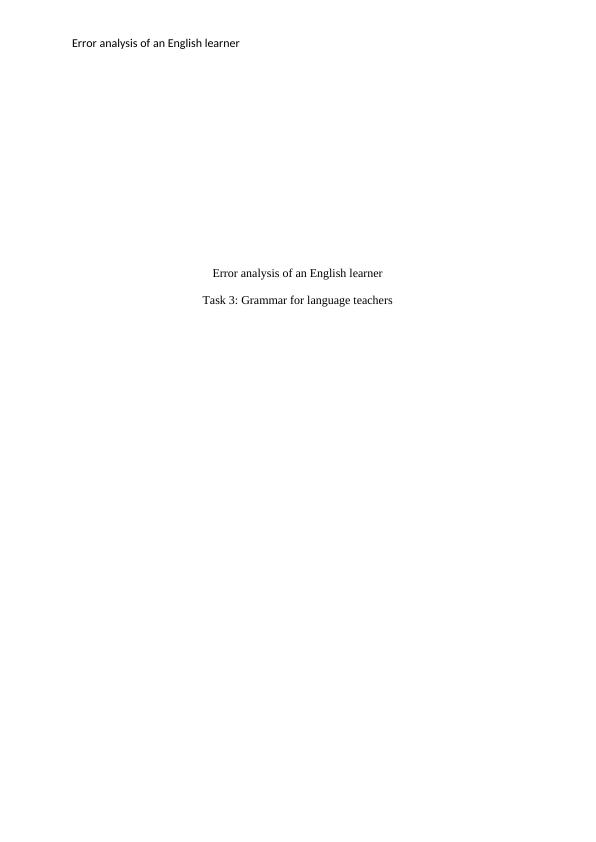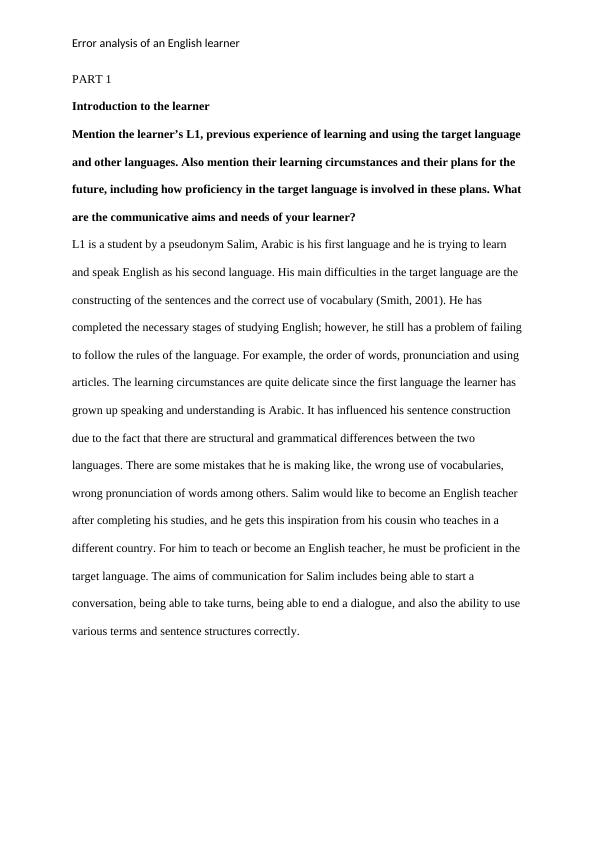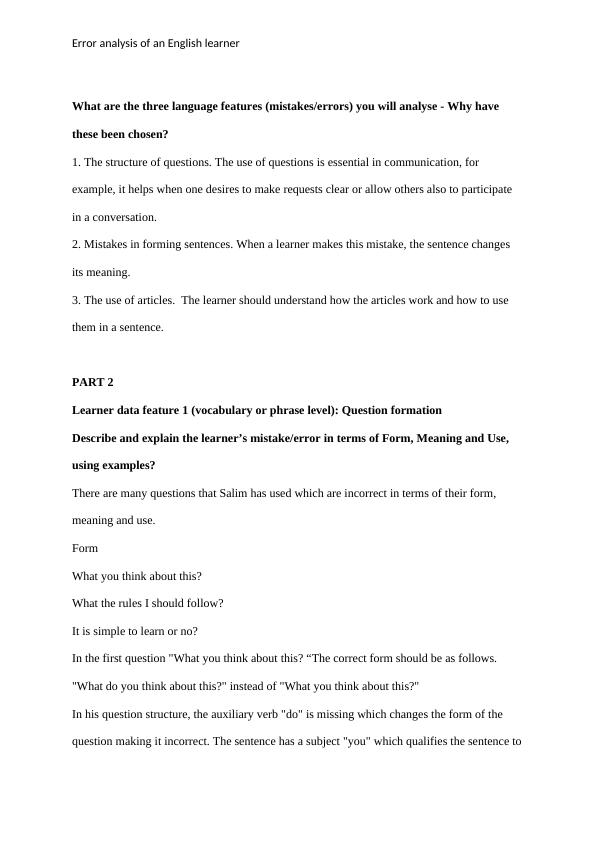Error analysis of an English learner
Added on 2023-06-05
16 Pages5103 Words73 Views
Error analysis of an English learner
Error analysis of an English learner
Task 3: Grammar for language teachers
Error analysis of an English learner
Task 3: Grammar for language teachers

Error analysis of an English learner
PART 1
Introduction to the learner
Mention the learner’s L1, previous experience of learning and using the target language
and other languages. Also mention their learning circumstances and their plans for the
future, including how proficiency in the target language is involved in these plans. What
are the communicative aims and needs of your learner?
L1 is a student by a pseudonym Salim, Arabic is his first language and he is trying to learn
and speak English as his second language. His main difficulties in the target language are the
constructing of the sentences and the correct use of vocabulary (Smith, 2001). He has
completed the necessary stages of studying English; however, he still has a problem of failing
to follow the rules of the language. For example, the order of words, pronunciation and using
articles. The learning circumstances are quite delicate since the first language the learner has
grown up speaking and understanding is Arabic. It has influenced his sentence construction
due to the fact that there are structural and grammatical differences between the two
languages. There are some mistakes that he is making like, the wrong use of vocabularies,
wrong pronunciation of words among others. Salim would like to become an English teacher
after completing his studies, and he gets this inspiration from his cousin who teaches in a
different country. For him to teach or become an English teacher, he must be proficient in the
target language. The aims of communication for Salim includes being able to start a
conversation, being able to take turns, being able to end a dialogue, and also the ability to use
various terms and sentence structures correctly.
PART 1
Introduction to the learner
Mention the learner’s L1, previous experience of learning and using the target language
and other languages. Also mention their learning circumstances and their plans for the
future, including how proficiency in the target language is involved in these plans. What
are the communicative aims and needs of your learner?
L1 is a student by a pseudonym Salim, Arabic is his first language and he is trying to learn
and speak English as his second language. His main difficulties in the target language are the
constructing of the sentences and the correct use of vocabulary (Smith, 2001). He has
completed the necessary stages of studying English; however, he still has a problem of failing
to follow the rules of the language. For example, the order of words, pronunciation and using
articles. The learning circumstances are quite delicate since the first language the learner has
grown up speaking and understanding is Arabic. It has influenced his sentence construction
due to the fact that there are structural and grammatical differences between the two
languages. There are some mistakes that he is making like, the wrong use of vocabularies,
wrong pronunciation of words among others. Salim would like to become an English teacher
after completing his studies, and he gets this inspiration from his cousin who teaches in a
different country. For him to teach or become an English teacher, he must be proficient in the
target language. The aims of communication for Salim includes being able to start a
conversation, being able to take turns, being able to end a dialogue, and also the ability to use
various terms and sentence structures correctly.

Error analysis of an English learner
What are the three language features (mistakes/errors) you will analyse - Why have
these been chosen?
1. The structure of questions. The use of questions is essential in communication, for
example, it helps when one desires to make requests clear or allow others also to participate
in a conversation.
2. Mistakes in forming sentences. When a learner makes this mistake, the sentence changes
its meaning.
3. The use of articles. The learner should understand how the articles work and how to use
them in a sentence.
PART 2
Learner data feature 1 (vocabulary or phrase level): Question formation
Describe and explain the learner’s mistake/error in terms of Form, Meaning and Use,
using examples?
There are many questions that Salim has used which are incorrect in terms of their form,
meaning and use.
Form
What you think about this?
What the rules I should follow?
It is simple to learn or no?
In the first question "What you think about this? “The correct form should be as follows.
"What do you think about this?" instead of "What you think about this?"
In his question structure, the auxiliary verb "do" is missing which changes the form of the
question making it incorrect. The sentence has a subject "you" which qualifies the sentence to
What are the three language features (mistakes/errors) you will analyse - Why have
these been chosen?
1. The structure of questions. The use of questions is essential in communication, for
example, it helps when one desires to make requests clear or allow others also to participate
in a conversation.
2. Mistakes in forming sentences. When a learner makes this mistake, the sentence changes
its meaning.
3. The use of articles. The learner should understand how the articles work and how to use
them in a sentence.
PART 2
Learner data feature 1 (vocabulary or phrase level): Question formation
Describe and explain the learner’s mistake/error in terms of Form, Meaning and Use,
using examples?
There are many questions that Salim has used which are incorrect in terms of their form,
meaning and use.
Form
What you think about this?
What the rules I should follow?
It is simple to learn or no?
In the first question "What you think about this? “The correct form should be as follows.
"What do you think about this?" instead of "What you think about this?"
In his question structure, the auxiliary verb "do" is missing which changes the form of the
question making it incorrect. The sentence has a subject "you" which qualifies the sentence to

Error analysis of an English learner
use the auxiliary verb "do." Salim is influenced by his Arabic language when it comes to
forming questions. He does not use inversion in the form of the question, and that is a
negative consequence of being used to the first language. Most people from non-English
speaking countries are said to have that problem when it comes to question formation
(Thornbury, 1997).
“What the rules I should follow? “
The correct form should be “What are the rules I should follow?”
The missing verb to be "are" is also an influence of the native language. In Arabic, some
articles can be omitted, without affecting the meaning of the sentence. Therefore, while
constructing sentences, natives often leave out those articles. Salim is from Saudi, and since
the equivalent of the article “are “is not there in the Arabic language, he forms questions
without that article.
Salim is struggling with the problem which is cross-linguistic where the influence of Arabic
has a toll on the structure of his questions. Most people from Arabic speaking countries
would end a sentence with a question mark instead of converting the sentence. According to
Smith, (2001) in most cases there no question word that has been used. Arabic natives use the
question’s mark to close the sentence in writing to make it look like a question. An example
of that in a sentence can be as follows.
e.g. English: You coming? Arabic انت جاي؟ Ent Jai?
But the correct form should be “are you coming?”
Another question form with an error is “It is simple to learn or no?” The correct form is “is it
easy to learn or not?
The mistake in the sentence is the use of “its’ instead of “is it” and the use of “no” instead of
“not” The sentence is not inverted which makes it lose the form. Al-Mekhlafi, (2013) is of the
opinion and assertion that Salim fails to use the right articles and also fails to invert the
use the auxiliary verb "do." Salim is influenced by his Arabic language when it comes to
forming questions. He does not use inversion in the form of the question, and that is a
negative consequence of being used to the first language. Most people from non-English
speaking countries are said to have that problem when it comes to question formation
(Thornbury, 1997).
“What the rules I should follow? “
The correct form should be “What are the rules I should follow?”
The missing verb to be "are" is also an influence of the native language. In Arabic, some
articles can be omitted, without affecting the meaning of the sentence. Therefore, while
constructing sentences, natives often leave out those articles. Salim is from Saudi, and since
the equivalent of the article “are “is not there in the Arabic language, he forms questions
without that article.
Salim is struggling with the problem which is cross-linguistic where the influence of Arabic
has a toll on the structure of his questions. Most people from Arabic speaking countries
would end a sentence with a question mark instead of converting the sentence. According to
Smith, (2001) in most cases there no question word that has been used. Arabic natives use the
question’s mark to close the sentence in writing to make it look like a question. An example
of that in a sentence can be as follows.
e.g. English: You coming? Arabic انت جاي؟ Ent Jai?
But the correct form should be “are you coming?”
Another question form with an error is “It is simple to learn or no?” The correct form is “is it
easy to learn or not?
The mistake in the sentence is the use of “its’ instead of “is it” and the use of “no” instead of
“not” The sentence is not inverted which makes it lose the form. Al-Mekhlafi, (2013) is of the
opinion and assertion that Salim fails to use the right articles and also fails to invert the

End of preview
Want to access all the pages? Upload your documents or become a member.
Related Documents
Examining and Analyzing Student Errors from the Perspective of a Pedagogical Grammarlg...
|17
|3885
|175
Examining and Analyzing Student Errors from the Perspective of a Pedagogical Grammarlg...
|17
|3885
|285
Teacher Language Awareness | Assessment 1lg...
|4
|870
|11
The Role of Feedback in EFL Classes Assignmentlg...
|9
|2663
|156
Difficulties with Word Sounds, Spelling, and Meaning for EFL Learnerslg...
|7
|1884
|1
Qualitative Method Assessment Task: Data analysislg...
|5
|1702
|19
